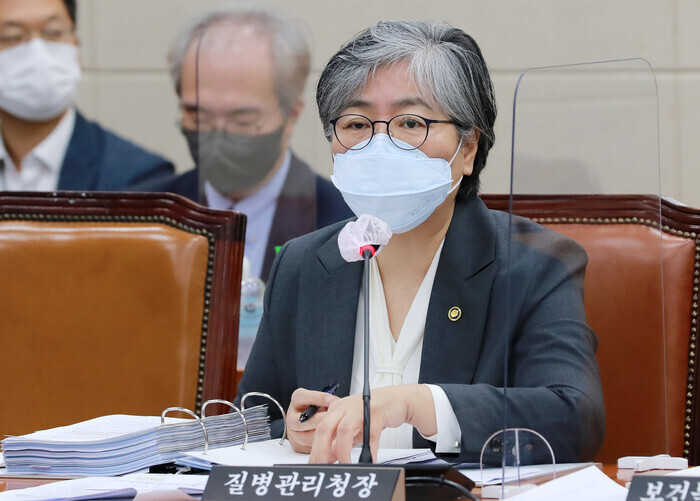hankyoreh
Links to other country sites 다른 나라 사이트 링크
Return to normal to start around Nov. 9, KDCA head says

The South Korean government announced that it will begin gradually restoring normal routines on Nov. 9. While the government had previously mentioned a timeframe of late October or early November, this is the first time it has offered a specific date.
The date came up when Jeong Eun-kyeong, commissioner of the Korea Disease Control and Prevention Agency (KDCA), was fielding a question from Kang Gi-yun, a lawmaker for the People Power Party, during a parliamentary audit in the National Assembly’s Health and Welfare Committee on Thursday morning.
“We’ve been told that we can start returning to normal routines when we reach a vaccination rate of 70% for the entire public, 80% for adults, and 90% for elderly people. Do you think we’ll reach that goal by Oct. 25?” Kang asked.
“I think that will be possible early in the week of Oct. 25,” Jeong said, adding that it’s necessary to “consider the two-week antibody formation period” when selecting the time for beginning a gradual return to normal routines.
When Kang asked if that would be around Nov. 9, Jeong said, “That’s our assumption.”
As of Thursday, South Korea was reporting a partial vaccination rate of 77.6% among the total public and a rate of 90.2% among adults aged 18 and above. With a complete vaccination rate of 55.5% among the entire public and a rate of 64.5% among adults aged 18 and above, Korea probably won’t have any trouble reaching its goal by Oct. 25.
Since early August, the government has been preparing to transition to an approach it calls the “gradual restoration of normal routines,” under which the scale of the epidemic will be gauged not by the daily case count but by the number of serious and critical patients and the case fatality rate. The government is exploring a coexistence strategy of ultimately managing COVID-19 on the level of the seasonal flu while focusing on protecting and treating the high-risk population.
There were concerns that the surge of new COVID-19 cases after the extended Chuseok holiday would disrupt the government’s plans. But on Sept. 28, Minister of Health and Welfare Kwon Deok-cheol reconfirmed the plan to gradually return to normal routines in early November by acquiring more hospital beds and expanding at-home treatment.
When Kang mentioned the need for an oral medication for COVID-19, Jeong said the government was “in deliberations to secure as large a supply as possible” and asked Kang to “help out in the review process at the National Assembly.”
The KDCA is planning to acquire 38,000 courses of molnupiravir, the COVID-19 pill developed by Merck and its partner Ridgeback Biotherapeutics, in 2021 and 2022.
By Kwon Ji-dam, staff reporter
Please direct questions or comments to [english@hani.co.kr]

Editorial・opinion
![[Guest essay] Preventing Korean Peninsula from becoming front line of new cold war [Guest essay] Preventing Korean Peninsula from becoming front line of new cold war](https://flexible.img.hani.co.kr/flexible/normal/500/300/imgdb/original/2024/0507/7217150679227807.jpg) [Guest essay] Preventing Korean Peninsula from becoming front line of new cold war
[Guest essay] Preventing Korean Peninsula from becoming front line of new cold war![[Column] The state is back — but is it in business? [Column] The state is back — but is it in business?](https://flexible.img.hani.co.kr/flexible/normal/500/300/imgdb/original/2024/0506/8217149564092725.jpg) [Column] The state is back — but is it in business?
[Column] The state is back — but is it in business?- [Column] Life on our Trisolaris
- [Editorial] Penalties for airing allegations against Korea’s first lady endanger free press
- [Editorial] Yoon must halt procurement of SM-3 interceptor missiles
- [Guest essay] Maybe Korea’s rapid population decline is an opportunity, not a crisis
- [Column] Can Yoon steer diplomacy with Russia, China back on track?
- [Column] Season 2 of special prosecutor probe may be coming to Korea soon
- [Column] Park Geun-hye déjà vu in Yoon Suk-yeol
- [Editorial] New weight of N. Korea’s nuclear threats makes dialogue all the more urgent
Most viewed articles
- 1Behind-the-times gender change regulations leave trans Koreans in the lurch
- 2Yoon’s revival of civil affairs senior secretary criticized as shield against judicial scrutiny
- 3South Korean ambassador attends Putin’s inauguration as US and others boycott
- 4Family that exposed military cover-up of loved one’s death reflect on Marine’s death
- 5Hybe-Ador dispute shines light on pervasive issues behind K-pop’s tidy facade
- 6[Guest essay] Preventing Korean Peninsula from becoming front line of new cold war
- 7[Editorial] New weight of N. Korea’s nuclear threats makes dialogue all the more urgent
- 8‘Weddingflation’ breaks the bank for Korean couples-to-be
- 9Yoon’s broken-compass diplomacy is steering Korea into serving US, Japanese interests
- 10U.S. band that performed in N. Korea looking forward to going back